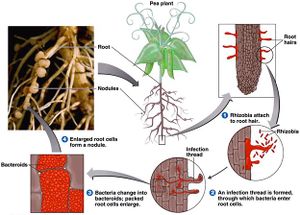Diazotrophs
Diazotrophs are a group of prokaryotic organisms with the ability to fix atmospheric nitrogen into ammonium or ammonia, forms usable to plants. (4) There are two types of terrestrial diazotrophs: those free living in the soil, and those that form symbiotic relationships with plants.

Nitrogen makes up the majority of the Earth’s atmosphere, but is mostly found in a form unusable to organisms. Atmospheric nitrogen (N2) is found as two nitrogen atoms held together by a triple bond. In this form, nitrogen is inaccessible. Diazotrophs have the ability to split, or “fix” these bonds, freeing the nitrogen molecules. This is crucial to the Earth's ecosystem. Nitrogen lost to anaerobic ammonium oxidation and denitrification need to be replenished to maintain the right amount of biologically available nitrogen in the soil. (3)
The nifH gene is used as an indicator of a diazotroph. It is a gene that encodes for the enzyme that is needed for the reduction of nitrogen, nitrogenase. Oxygen is harmful for this enzyme, so diazotrophs find ways to protect this. They often live in anaerobic environments, including in the roots of a plant or in soils.
The nifH gene
Diazotrophs are a group of organisms made up of Proteobacterias, Cyanobacterias, and Archeans. Nitrogen fixing organisms are very diverse, both physiologically and phylogenetically. The nifH gene is used as a biomarker to identify diazotrophs. (3) The nifH gene encodes for the enzyme nitrogenase reductase, which facilitates the reduction of nitrogen. This gene is the only one currently being used to identify nitrogen fixing organisms, but the presence of other nitrogen fixing systems in some organisms and multiple copies of the genes within other organisms suggests that it is not always an absolute marker of a diazotroph. (5)
Free Living Diazotrophs
Free living diazotrophs are nitrogen fixing organisms that live directly in the soil. They are able to fix nitrogen by using a nitrogenase protein, which is able to break nitrogen bonding. 16 molecules of ATP, plus 8 reducing equivalents, are required to reduce one molecule of atmospheric nitrogen gas.[4] This is a huge energy investment by the diazotroph. The energy investment needed increases in aerobic areas, because soil dwelling nitrogen fixers need to use a lot of energy to protect their nitrogenase from oxygen's damaging effects. (2) The least costly method of nitrogen fixation for free living diazotrophs is in microaerophilic environments, where there is enough oxygen for the bacteria to breathe, but not enough to harm their nitrogenase enzymes.
The Rhizosphere
There are greater populations of diazotrophs found in the rhizosphere than there are found in bulk soil. This is hypothesized to be due to the fact that, during the vegetation period, the amount of amino acids released by plants does not have sufficient amounts of nitrogen to support the microbial life. This can give diazotrophs an advantage, as they are able to fix their own nitrogen. (5)
Common diazotrophs found in the rhizosphere include Azotobacter, Azospirillum and Herbaspirillum.
Symbiotic Diazotrophs

The enzymes that are needed to fix nitrogen are easily damaged by oxygen, so some diazotophs form symbiotic relationships with plants. In this relationship, diazaotophs have protection from oxygen's damaging properties, while also being supplied carbon, and energy. In exchange for this, plants benefit from the nitrogen being fixed inside their roots. They do this by living in nodules that form on the roots of plants. Inside these nodules live clusters of bacteria that are able to fix nitrogen without the harmful effects of an open environment. The color of the nodule is indicative of the processes occurring within. Green nodules mean the bacteria are reproducing, pink means they are actively fixing nitrogen, and white means they are transitioning.
The most common plant family that creates symbiotic relationships with diazotrophs is the Fabaceae or Leguminosae family, which includes leguminous plants.
Common symbiotic diazotrophs include bacteria from the genus Rhizobium and Frankia, among others.
Nod Factor
Bacteria from the genus Rhizobium form a relationship with leguminous plants. Parasponia is the only non-legume genus that can form a symbiotic relationship with these bacteria. They do this by using the nodulation factor, or nod factor - a signal of amino acids that alert the plant. The nod factor is sent out as a response to flavonoids sent out by leguminous plants. When the bacteria sends out this signal, the plant responds with root hairs curling around the bacteria. As the intracellular infection threads from the bacteria begin to grow into the plants, the plant begins nodule formation. The nodule become surrounded by a membrane from plant material. Symbiosome is the name for this compartmentalization of bacteria within the plant, and it is the symbiosome that acts as the pathway between the plant and the bacteria, allowing for nutrient exchange.
References
[1] Streng, Arend, et al. “Evolutionary Origin of Rhizobium Nod Factor Signaling.” Plant Signaling & Behavior, vol. 6, no. 10, 2011, pp. 1510–1514., doi:10.4161/psb.6.10.17444.
[2] Stein, Lisa Y, and Martin G Klotz. “The Nitrogen Cycle.” Current Biology Magazine , vol. 26, no. 3, 8 Feb. 2016, pp. R94–R98.
[3] Jetten, Mike S. M. “The microbial nitrogen cycle.” Environmental Microbiology, vol. 10, no. 11, 2008, pp. 2903–2909., doi:10.1111/j.1462-2920.2008.01786.x.
[4] Norman, Jeffrey S, and Maren L Friesen. “Complex N acquisition by soil diazotrophs: how the ability to release exoenzymes affects N fixation by terrestrial free-Living diazotrophs.” The ISME Journal, vol. 11, no. 2, 1 Feb. 2017, pp. 315–326., doi:10.1038/ismej.2016.127.
[5] Burgmann, Helmut, et al. “Effects of model root exudates on structure and activity of a soil diazotroph community.” Environmental Microbiology, vol. 7, no. 11, 1 Nov. 2005, pp. 1711–1724., doi:10.1111/j.1462-2920.2005.00818.x.
[6] Burgmann, H., et al. “New Molecular Screening Tools for Analysis of Free-Living Diazotrophs in Soil.” Applied and Environmental Microbiology, vol. 70, no. 1, Jan. 2004, pp. 240–247., doi:10.1128/aem.70.1.240-247.2004.
[7] Poulin, Jessica. Evolutionary Biology Lab Manual. 8th ed.
[9] Pearson Education, Inc